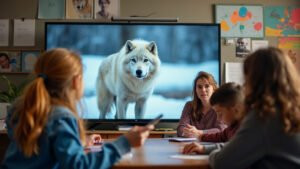Introduction
Virtual reality (VR) is revolutionizing education by providing immersive and interactive learning experiences. When it comes to teaching about Arctic wolves, VR can transport students to the Arctic environment, allowing them to observe these majestic animals in their natural habitat
This article explores the benefits of using VR in education, how it creates immersive learning experiences, the tools available for teaching about Arctic wolves, integration strategies, technological and safety considerations, and methods for assessing student learning in VR environments
Benefits of Using Virtual Reality in Education
Virtual reality (VR) is revolutionizing education by offering unique and engaging ways to present information. By immersing students in a virtual environment, VR can make learning more interactive and impactful
Here, we explore how VR enhances student engagement and improves retention and understanding, particularly in the context of teaching about Arctic wolves
Enhancing Student Engagement
One of the most significant benefits of VR in education is its ability to captivate students’ attention and foster active participation. Traditional teaching methods often involve passive learning, where students listen to lectures or read textbooks
In contrast, VR requires students to engage directly with the content. For example, in a virtual Arctic environment, students can observe Arctic wolves in their natural habitat, interact with the landscape, and even participate in simulated activities such as tracking wolves or studying their behavior. This level of engagement can make the learning experience more enjoyable and memorable
Studies have shown that VR can significantly boost student motivation and interest
A research study by Makransky and Lilleholt (2018) found that students who used VR for learning reported higher levels of engagement and intrinsic motivation compared to those who used traditional methods. This increased engagement can lead to deeper learning and a greater willingness to explore and understand complex topics
Improving Retention and Understanding
In addition to enhancing engagement, VR can also improve students’ retention and comprehension of information. The immersive nature of VR allows students to experience and interact with educational content in a way that is not possible with traditional methods
For instance, when learning about Arctic wolves, students can virtually explore the Arctic tundra, observe wolf pack dynamics, and see how wolves hunt and survive in harsh conditions. This experiential learning approach helps students to visualize and better understand the subject matter
Research supports the effectiveness of VR in improving retention rates. A study published in the Journal of Educational Psychology (2020) found that students who learned through VR simulations demonstrated a 30% improvement in retention rates compared to those who learned through conventional methods
This suggests that VR can help students to retain information more effectively by providing a memorable and interactive learning experience
Furthermore, VR allows for the simulation of complex processes and environments, which can enhance understanding. For example, students can witness the impact of climate change on Arctic habitats, see how Arctic wolves adapt to seasonal changes, and understand the predator-prey relationships in the ecosystem
These simulations provide a comprehensive understanding of the topics, making the learning experience more profound and informative
By incorporating VR into their teaching strategies, educators can create a dynamic and effective learning environment that not only captures students’ interest but also enhances their comprehension and retention of the subject matter
The use of VR in education, particularly for teaching about Arctic wolves, offers a powerful tool for making learning more engaging, interactive, and impactful
Creating Immersive Learning Experiences with VR
Virtual reality (VR) offers unparalleled opportunities for creating immersive learning experiences, allowing students to explore environments and interact with content in ways that traditional teaching methods cannot match
When it comes to teaching about Arctic wolves, VR can transport students directly into the Arctic, providing a realistic and engaging way to learn about these fascinating animals
Understanding Arctic Wolf Behavior and Habitat
One of the most powerful aspects of VR is its ability to create realistic simulations of environments and behaviors. For Arctic wolves, this means students can observe the animals in their natural habitat without ever leaving the classroom
In a VR simulation, students can explore the Arctic tundra, watch wolves hunt, and see how they interact with their pack and environment. This firsthand experience can deepen students’ understanding of Arctic wolf behavior, including their hunting strategies, social structures, and adaptations to extreme cold
For instance, students can witness a virtual wolf pack tracking and hunting caribou, observing how they use teamwork and strategy to bring down prey. This type of interactive learning helps students grasp complex concepts in ecology and animal behavior more effectively than through textbooks or lectures alone
Virtual Field Trips to the Arctic
VR enables virtual field trips, providing students with experiences that would be logistically and financially impossible otherwise
A virtual field trip to the Arctic can include exploring the icy landscapes, learning about the flora and fauna, and understanding the challenges of survival in such a harsh climate. These immersive experiences can make lessons about the Arctic ecosystem and Arctic wolves more vivid and memorable
During a virtual field trip, students can follow an Arctic wolf as it navigates its territory, encountering various environmental challenges and other wildlife
They can also witness seasonal changes in the Arctic, such as the transformation from summer to winter, and see how these changes affect the wolves and their prey. This comprehensive exploration can provide a holistic understanding of the Arctic environment and the survival strategies of Arctic wolves
Moreover, virtual field trips can be tailored to include interactive elements, such as quizzes, challenges, and discussion points, to reinforce learning objectives and encourage active participation. By immersing students in the Arctic environment, VR can help them develop a deeper connection to the subject matter and foster a greater appreciation for the natural world
By leveraging the immersive capabilities of VR, educators can create engaging and educational experiences that bring the study of Arctic wolves to life. These virtual experiences not only enhance understanding and retention but also inspire curiosity and a sense of adventure in students
VR Tools and Integration for Teaching About Arctic Wolves
To effectively utilize virtual reality (VR) for teaching about Arctic wolves, educators need to be aware of the various tools and strategies available
This section covers popular VR platforms, specialized educational VR applications, designing VR-based lessons, and aligning VR activities with curriculum standards
Popular VR Platforms
Several VR platforms are widely used in educational settings, offering a range of features and content
Some of the most popular include:
Oculus Rift and Quest: These platforms offer a wide variety of educational apps and experiences. The Oculus Quest, in particular, is a standalone device that is user-friendly and accessible for classroom use
HTC Vive: Known for its high-quality graphics and immersive experiences, the HTC Vive is another popular choice for educational VR applications
Google Expeditions: This platform allows teachers to take students on virtual field trips to various locations, including the Arctic. It’s particularly useful for schools with limited budgets, as it works with affordable VR viewers like Google Cardboard
These platforms provide diverse experiences and can be adapted for different educational purposes, including the study of Arctic wolves
Specialized Educational VR Applications
Several VR applications are specifically designed for educational use, offering detailed simulations and interactive content
Some noteworthy applications for teaching about Arctic wolves include:
Wild Immersion: This app provides immersive wildlife experiences, allowing students to observe Arctic wolves in their natural habitat
VR Lessons by Thinglink: This platform offers interactive 360-degree images and videos, which can include content about Arctic wolves and their environment
InMind2: Although not specifically about Arctic wolves, this educational VR game can be used to teach broader scientific concepts that can be applied to understanding animal behavior and biology
These specialized applications provide educators with the tools to create engaging and informative lessons about Arctic wolves and their ecosystem
Designing VR-based Lessons
Integrating VR into lesson plans requires careful planning to ensure that the technology enhances learning objectives
Here are some steps to design effective VR-based lessons:
Identify Learning Objectives: Clearly define what students should learn from the VR experience. For example, objectives could include understanding Arctic wolf behavior, learning about their adaptations to the Arctic environment, and exploring the ecological relationships within the Arctic tundra
Select Appropriate VR Content: Choose VR experiences that align with the learning objectives. This could include virtual field trips, simulations of wolf behavior, or interactive 3D models of the Arctic ecosystem
Plan Pre- and Post-VR Activities: To maximize the educational impact, design activities to prepare students for the VR experience and to reinforce learning afterward. Pre-VR activities could include reading assignments or discussions about Arctic wolves, while post-VR activities might involve quizzes, reflection essays, or group projects
Ensure Accessibility: Make sure all students have access to the necessary VR equipment and that the content is suitable for their age and skill level
By carefully planning VR-based lessons, educators can create engaging and effective learning experiences that help students gain a deeper understanding of Arctic wolves
Aligning VR Activities with Curriculum Standards
To ensure that VR activities are educationally valuable, they should be aligned with curriculum standards. This alignment ensures that the VR experiences contribute to students’ overall learning goals and academic requirements
Here’s how to align VR activities with curriculum standards:
Review Relevant Standards: Identify the educational standards related to the subject matter. For Arctic wolves, this might include standards in science, geography, and biology
Match VR Content to Standards: Ensure that the VR activities cover the topics and skills outlined in the standards. For example, a VR simulation of Arctic wolf behavior can meet standards related to animal adaptations and ecosystems
Document Learning Outcomes: Clearly document how the VR activities meet specific standards and learning objectives. This documentation can be used to demonstrate the educational value of the VR experiences to administrators and parents
Assess Student Learning: Use assessments that align with the curriculum standards to evaluate students’ understanding and retention of the material learned through VR. This can include traditional tests, projects, and presentations
By aligning VR activities with curriculum standards, educators can ensure that the use of VR in the classroom is both engaging and academically rigorous
Technological and Safety Considerations
Implementing VR in the classroom requires careful consideration of the technological and safety aspects to ensure a smooth and safe learning experience
Classroom VR Setup Requirements
Setting up VR in a classroom involves several key components:
VR Headsets: Ensure there are enough headsets for the students, and that they are compatible with the chosen VR platform
Computers or Standalone Devices: Depending on the VR platform, you may need high-performance computers or standalone VR devices like the Oculus Quest
Space: Allocate sufficient space for students to move around safely while using VR. Clear any obstacles to prevent accidents
Internet Connectivity: A reliable internet connection is essential for downloading VR content and updates
Proper setup and maintenance of the VR equipment are crucial for a successful implementation
Ensuring Student Safety in VR Environments
Safety is paramount when using VR in the classroom. Here are some guidelines to ensure student safety:
Supervision: Always supervise students while they are using VR to assist with any technical issues and ensure they are using the equipment correctly
Health Considerations: Be aware of any students with health conditions that may be affected by VR, such as epilepsy or motion sickness. Provide alternative activities for these students
Breaks: Encourage students to take regular breaks to prevent eye strain and fatigue. A good rule of thumb is a 10-minute break for every 30 minutes of VR use
Clear Instructions: Provide clear instructions on how to use the VR equipment safely, including how to adjust the headset and what to do if they feel uncomfortable
By addressing these technological and safety considerations, educators can create a safe and effective VR learning environment
Assessing Student Learning in VR
Assessing student learning in VR environments involves evaluating both the engagement and understanding of the material presented through VR experiences
Evaluation Methods for VR Learning
Several methods can be used to assess student learning in VR:
Quizzes and Tests: Traditional quizzes and tests can be used to evaluate students’ understanding of the material learned through VR
Observation: Teachers can observe students during VR activities to assess their engagement and participation
Projects and Presentations: Assign projects or presentations where students can demonstrate their understanding of the Arctic wolves and the concepts learned through VR
Reflection Essays: Encourage students to write essays reflecting on their VR experience and what they learned
These evaluation methods can provide a comprehensive assessment of student learning in VR environments
Measuring Engagement and Understanding
To measure student engagement and understanding, consider the following approaches:
Surveys and Feedback: Collect feedback from students about their VR experience to gauge their level of engagement and interest
Performance Metrics: Track performance metrics within the VR applications, such as completion rates and scores, to assess understanding and progress
Interactive Assessments: Use interactive assessments within the VR experience, such as in-app quizzes and challenges, to evaluate real-time understanding
Conclusion
Virtual reality (VR) offers an innovative and effective way for educators to teach students about Arctic wolves
By leveraging VR technology, teachers can create immersive learning experiences that enhance student engagement and comprehension. Students can observe Arctic wolves in their natural habitat, understand their behavior, and explore the challenges they face in the Arctic environment
The benefits of using VR in education are significant. It captures students’ attention and fosters active participation, leading to higher levels of motivation and interest. Studies have shown that VR can improve retention rates and deepen understanding, making it a valuable tool for teaching complex subjects
To successfully integrate VR into the classroom, educators need to select appropriate VR platforms and specialized educational applications
Popular VR tools like Oculus Quest, HTC Vive, and Google Expeditions offer diverse experiences that can be tailored to educational needs. Designing VR-based lessons and aligning them with curriculum standards ensure that these experiences are educationally valuable
Technological and safety considerations are crucial for effective implementation. Proper VR setup, adequate space, and reliable internet connectivity are essential. Ensuring student safety through supervision, clear instructions, and regular breaks is paramount
Finally, assessing student learning in VR environments involves a mix of traditional and interactive methods, such as quizzes, projects, and performance metrics within the VR applications. By evaluating engagement and understanding, educators can optimize the use of VR to enhance the educational experience
Incorporating VR into lessons about Arctic wolves not only makes learning more engaging and interactive but also provides students with a deeper appreciation and understanding of these remarkable animals and their environment










